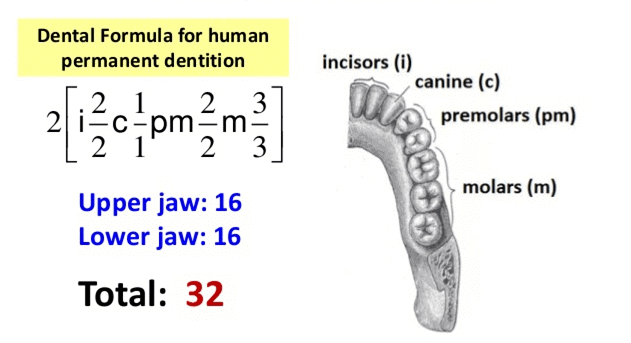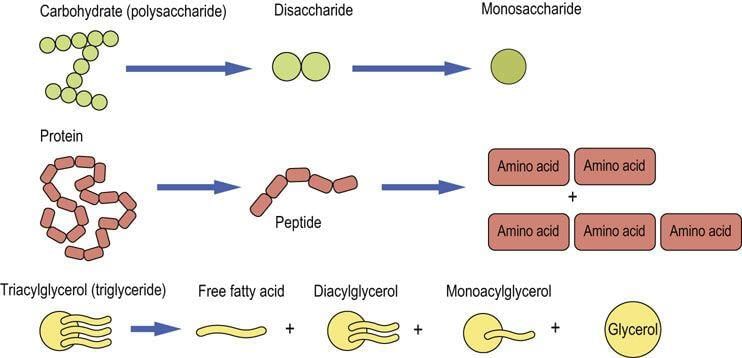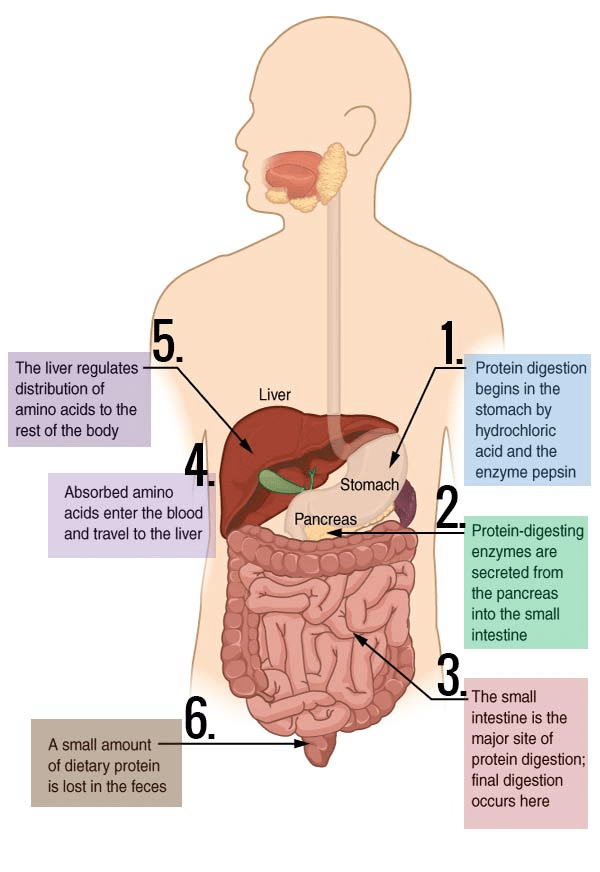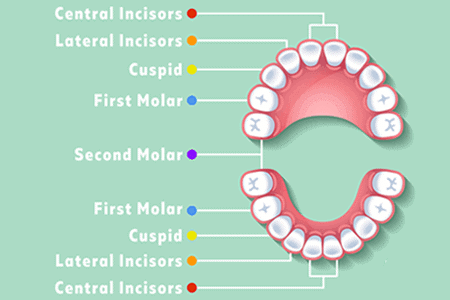Digestion & Absorption (Old NCERT) NCERT Solutions | General Science for Competitive Exams - RRB Group D / RPF Constable PDF Download
Q.1. Choose the correct answer among the following:
(a) Gastric juice contains
(i) pepsin, lipase and rennin
(ii) trypsin lipase and rennin
(iii) trypsin, pepsin and lipase
(iv) trypsin, pepsin and renin
(b) Succus entericus is the name given to
(i) a junction between ileum and large intestine
(ii) intestinal juice
(iii) swelling in the gut
(iv) appendix
Ans.
(a) (i) Pepsin, lipase, and rennin
- Gastric juice contains pepsin, lipase, and rennin. Pepsin is secreted in an inactive form as pepsinogen, which is activated by HCl. Pepsin digests proteins into peptones. Lipase breaks down fats into fatty acids. Rennin is a photolytic enzyme present in the gastric juice. It helps in the coagulation of milk.
(b) (ii) Intestinal juice
- Succus entericus is another name for intestinal juice. It is secreted by the intestinal gland. Intestinal juice contains a variety of enzymes such as maltase, lipases, nucleosidases, dipeptidases, etc.
Q.2. Match column I with column II

Ans.

Q.3. Answer briefly:
(a) Why are villi present in the intestine and not in the stomach?
(b) How does pepsinogen change into its active form?
(c) What are the basic layers of the wall of alimentary canal?
(d) How does bile help in the digestion of fats?
Ans.
(a)
- The mucosal wall of the small intestine forms millions of tiny finger-likeprojections known as villi. These villi increase the surface area for more efficient food absorption.
- Within these villi, there are numerous blood vessels that absorb the digested products of proteins and carbohydrates, carrying them to the blood stream. The villi also contain lymph vessels for absorbing the products of fat-digestion. From the blood stream, the absorbed food is finally delivered to each and every cell of the body.
- The mucosal walls of the stomach form irregular folds known as rugae. These help increase the surface area to volume ratio of the expanding stomach.
(b)
- Pepsinogen is a precursor of pepsin stored in the stomach walls. It is converted into pepsin by hydrochloric acid. Pepsin is activated in the form of pepsinogen.
- Pepsinogen → Pepsin + Inactive peptide
(Inactive) (Active)
(c) The walls of the alimentary canal are made up of four layers. These are as follows:
 Walls of Alimentary canal
Walls of Alimentary canal
- Serosa is the outermost layer of the human alimentary canal. It is made up of a thin layer of secretory epithelial cells, with some connective tissues underneath.
- Muscularis is a thin layer of smooth muscles arranged into an outer longitudinal layer and an inner circular layer.
- Sub-mucosa is a layer of loose connective tissues, containing nerves, blood, and lymph vessels. It supports the mucosa.
- Mucosa is the innermost lining of the lumen of the alimentary canal. It is mainly involved in absorption and secretion.
(d)
- Bile is a digestive juice secreted by the liver and stored in the gall bladder.
- Bile juice has bile salts such as bilirubin and biliverdin. These break down large fat globules into smaller globules so that the pancreatic enzymes can easily act on them.
- This process is known as emulsification of fats. Bile juice also makes the medium alkaline and activates lipase.
Q.4. State the role of pancreatic juice in digestion of proteins.
Ans. Pancreatic juice contains a variety of inactive enzymes such as trypsinogen, chymotrypsinogen, and carboxypeptidases. These enzymes play an important role in the digestion of proteins.
Physiology of Protein digestion
- The enzyme enterokinase is secreted by the intestinal mucosa. It activates trypsinogen into trypsin.
- Trypsin then activates the other enzymes of pancreatic juice such as chymotrypsinogen and carboxypeptidase. Chymotrypsinogen is a milk-coagulating enzyme that converts proteins into peptides.
- Carboxypeptidase acts on the carboxyl end of the peptide chain and helps release the last amino acids. Hence, it helps in the digestion of proteins.
- Thus, in short, we can say that the partially-hydrolysed proteins present in the chyme are acted upon by various proteolytic enzymes of the pancreatic juice for their complete digestion.
Q.5. Describe the process of digestion of protein in stomach.
Ans.
- The digestion of proteins begins in the stomach and is completed in the small intestine. The digestive juice secreted in the gastric glands present on the stomach walls is called gastric juice. The food that enters the stomach becomes acidic on mixing with this gastric juice.
- The main components of gastric juice are hydrochloric acid, pepsinogen, mucus, and rennin. Hydrochloric acid dissolves the bits of food and creates an acidic medium so that pepsinogen is converted into pepsin. Pepsin is a protein- digesting enzyme. It is secreted in its inactive form called pepsinogen, which then gets activated by hydrochloric acid. The activated pepsin then converts proteins into proteases and peptides.
- Rennin is a proteolytic enzyme, released in an inactive form called prorennin. Rennin plays an important role in the coagulation of milk.
Q.6. Given the dental formula of human beings.
Ans.The dental formula expresses the arrangement of teeth in each half of the upper jaw and the lower jaw.
 Dental Formula
Dental Formula
The entire formula is multiplied by two to express the total number of teeth.
- The dental formula for milk teeth in humans is
- Each half of the upper jaw and the lower jaw has 2 incisors, 1 canine, and 2 molars.
Premolars are absent in milk teeth. - The dental formula for permanent teeth in humans is
- Each half of the upper jaw and the lower jaw has 2 incisors, 1 canine, 2 premolars, and 3 molars. An adult human has 32 permanent teeth.
Q.7. Bile juice contains no digestive enzymes, yet it is important for digestion. Why?
Ans.
- Bile is a digestive juice secreted by the liver. Although it does not contain any digestive enzymes, it plays an important role in the digestion of fats.
- Bile juice has bile salts such as bilirubin and biliverdin. These break down large fat globules into smaller globules so that the pancreatic enzymes can easily act on them. This process is known as emulsification of fats. Bile juice also makes the medium alkaline and activates lipase.
Q.8. Describe the digestive role of chymotrypsin. Which two other digestive enzymes of the same category are secreted by its source gland?
Ans.
- The enzyme trypsin (present in the pancreatic juice) activates the inactive enzyme chymotrypsinogen into chymotrypsin.
Chymotrypsinogen Chymotrypsin
Chymotrypsin
(Inactive) (Active) - The activated chymotrypsin plays an important role in the further breakdown of the partially-hydrolysed proteins.
Proteins Peptides
Peptides - The other digestive enzymes of the same category are trypsinogen and carboxypeptidase. These are secreted by the same source-gland, pancreas.
- Trypsinogen is present in an inactive form in the pancreatic juice. The enzyme enterokinase – secreted by the intestinal mucosa – activates trypsinogen into trypsin.
Trypsinogen Trypsin + Inactive peptide
Trypsin + Inactive peptide - The activated trypsin then further hydrolyses the remaining trypsinogen and activates other pancreatic enzymes such as chymotrypsinogen and carboxypeptidase. Trypsin also helps in breaking down proteins into peptides.
Proteins Peptides
Peptides - Carboxypeptidases act on the carboxyl end of the peptide chain and help in releasing the last amino acids.
Peptides Small peptide chain + Amino acids
Small peptide chain + Amino acids
Q.9. How are polysaccharides and disaccharides digested?
Ans.
- The digestion of carbohydrates takes place in the mouth and the small intestine region of the alimentary canal. The enzymes that act on carbohydrates are collectively known as carbohydrases.
 Disaccharides
Disaccharides
Digestion in the Mouth
- As food enters the mouth, it gets mixed with saliva. Saliva – secreted by the salivary glands – contains a digestive enzyme called salivary amylase. This enzyme breaks down starch into sugar at pH 6.8.
Starch Maltose + Isomaltose + Limit dextrins
Maltose + Isomaltose + Limit dextrins - Salivary amylase continues to act in the oesophagus, but its action stops in the stomach as the contents become acidic. Hence, carbohydrate-digestion stops in the stomach.
Digestion in the Small Intestine
- Carbohydrate-digestion is resumed in the small intestine. Here, the food gets mixed with the pancreatic juice and the intestinal juice. Pancreatic juice contains the pancreatic amylase that hydrolyses the polysaccharides into disaccharides.
Starch Disaccharides
Disaccharides
(Polysaccharides) - Similarly, the intestinal juice contains a variety of enzymes (disaccharidases such as maltase, lactase, sucrase, etc.). These disaccharidases help in the digestion of disaccharides. The digestion of carbohydrates is completed in the small intestine.
Q.10. What would happen if HCl were not secreted in the stomach?
Ans.
- Hydrochloric acid is secreted by the glands present on the stomach walls. It dissolves bits of food and creates an acidic medium. The acidic medium allows pepsinogen to be converted into pepsin.
- Pepsin plays an important role in the digestion of proteins. Therefore, if HCl were not secreted in the stomach, then pepsin would not be activated. This would affect protein digestion. A pH of about 1.8 is necessary for proteins to be digested. This pH is achieved by HCl.
Q.11. How does butter in your food gets digested and absorbed in the body?
Ans.
Digestion of Fats
- Butter is a fat product and gets digested in the small intestine. The bile juice secreted by the liver contains bile salts that break down large fat globules into smaller globules, so as to increase their surface area for the action of lipase. This process is referred to as emulsification of fats.
- After this, the pancreatic lipase present in the pancreatic juice and the intestinal lipase present in the intestinal juice hydrolyse the fat molecules into triglycerides, diglycerides, monoglycerides, and ultimately into glycerol.
Fats Triglycerides + Diglycerides
Triglycerides + Diglycerides
Diglycerides and monoglycerides Fatty acids + Glycerol
Fatty acids + Glycerol
Absorption of Fats
- Fat absorption is an active process. During fat digestion, fats are hydrolysed into fatty acids and glycerol. However, since these are water insoluble, they cannot be directly absorbed by the blood. Hence, they are first incorporated into small droplets called micelles and then transported into the villi of the intestinal mucosa.
- They are then reformed into small microscopic particles called chylomicrons, which are small, protein-coated fat globules. These chylomicrons are transported to the lymph vessels in the villi. From the lymph vessels, the absorbed food is finally released into the blood stream and from the blood stream, to each and every cell of the body.
Q.12. Discuss the main steps in the digestion of proteins as the food passes through different parts of the alimentary canal.
Ans.
- The digestion of proteins begins in the stomach and is completed in the small intestine. The enzymes that act on proteins are known as proteases.
 Digestion of Protein
Digestion of Protein
- The digestive juice secreted in the gastric glands present on the stomach walls is called gastric juice. The main components of gastric juice are HCl, pepsinogen, and rennin. The food that enters the stomach becomes acidic on mixing with this gastric juice.
- The acidic medium converts inactive pepsinogen into active pepsin. The active pepsin then converts proteins into proteases and peptides.
Proteins Proteases + Peptides
Proteases + Peptides - The enzyme rennin plays an important role in the coagulation of milk.
- Digestion in the small intestine. The food from the stomach is acted upon by three enzymes present in the small intestine – pancreatic juice, intestinal juice (known as succus entericus), and bile juice.
Action of Pancreatic Juice
- Pancreatic juice contains a variety of inactive enzymes such as trypsinogen, chymotrypsinogen, and carboxypeptidases. The enzymes are present in an inactivated state. The enzyme enterokinase secreted by the intestinal mucosa activates trypsinogen into trypsin.
Trypsinogen Trypsin + Inactive peptide
Trypsin + Inactive peptide - The activated trypsin then activates the other enzymes of pancreatic juice. Chymotrypsinogen is a proteolytic enzyme that breaks down proteins into peptides.
Chymotrypsinogen Chymotrypsin
Chymotrypsin
Proteins Peptides
Peptides - Carboxypeptidases act on the carboxyl end of the peptide chain and help in releasing the last amino acids.
Peptides Smaller peptide chain + Amino acids
Smaller peptide chain + Amino acids
Action of Bile Juice
- Bile juice has bile salts such as bilirubin and biliverdin which break down large, fat globules into smaller globules so that pancreatic enzymes can easily act on them. This process is known as emulsification of fats.
- Bile juice also makes the medium alkaline and activates lipase. Lipase then breaks down fats into diglycerides and monoglycerides.
Action of Intestinal Juice
- Intestinal juice contains a variety of enzymes. Pancreatic amylase digests polysaccharides into disaccharides. Disaccharidases such as maltase, lactase, sucrase, etc., further digest the disaccharides.
- The proteases hydrolyse peptides into dipeptides and finally into amino acids.
Dipeptides Amino acids
Amino acids - Pancreatic lipase breaks down fats into diglycerides and monoglycerides. The nucleases break down nucleic acids into nucleotides and nucleosides.
Q.13. Explain the term thecodont and diphyodont.
Ans.
- Thecodont is a type of dentition in which the teeth are embedded in the deep sockets of the jaw bone. Ankylosis is absent and the roots are cylindrical. Examples include living crocodilians and mammals.
- Diphyodont is a type of dentition in which two successive sets of teeth are developed during the lifetime of the organism. The first set of teeth is deciduous and the other set is permanent. The deciduous set of teeth is replaced by the permanent adult teeth. This type of dentition can be seen in humans.
Q.14. Name different types of teeth and their number in an adult human.
Ans. There are four different types of teeth in an adult human.
 Name of Teeth
Name of Teeth
(i) Incisors
The eight teeth in the front are incisors. There are four incisors each in the upper jaw and the lower jaw. They are meant for cutting.
(ii) Canines
The pointy teeth on either side of the incisors are canines. They are four in number, two each placed in the upper jaw and the lower jaw. They are meant for tearing.
(iii) Premolars
They are present next to the canines. They are eight in number, four each placed in the upper jaw and the lower jaw. They are meant for grinding.
(iv) Molars
They are present at the end of the jaw, next to the premolars. There are twelve molars, six each placed in the upper jaw and the lower jaw.
Hence, the dental formula in humans is
This means each half of the upper jaw and the lower jaw has 2 incisors, 1 canine, 2 premolars, and 3 molars. Hence, an adult human has 32 permanent teeth.
Q.15. What are the functions of liver?
Ans. Liver is the largest and heaviest internal organ of the body. It is not directly involved in digestion, but secretes digestive juices. It secretes bile which plays a major role in the emulsification of fats.
|
365 docs|169 tests
|
FAQs on Digestion & Absorption (Old NCERT) NCERT Solutions - General Science for Competitive Exams - RRB Group D / RPF Constable
| 1. What is the process of digestion and absorption? |  |
| 2. What are the different types of digestive enzymes? |  |
| 3. What are the functions of the liver and pancreas in digestion and absorption? |  |
| 4. What are some common digestive disorders? |  |
| 5. How can one maintain good digestive health? |  |






















